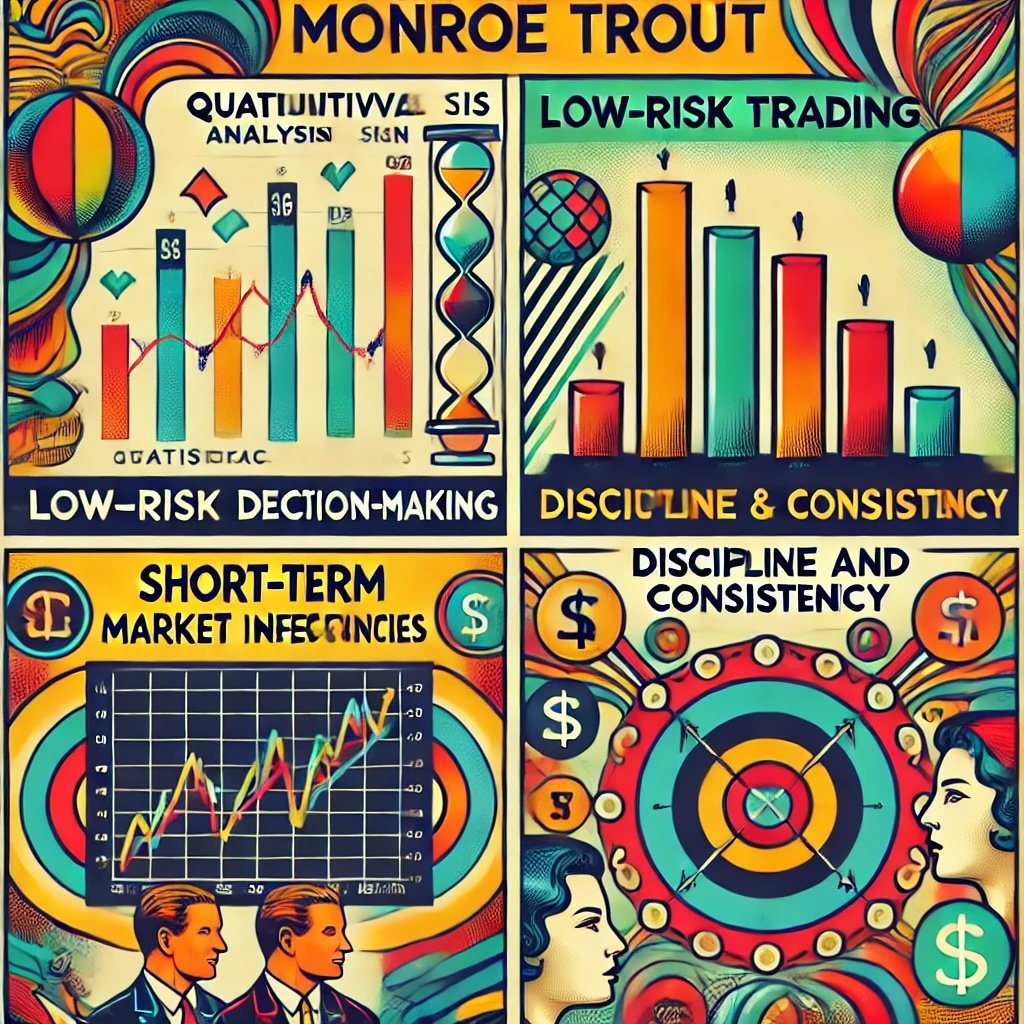Investing like a seasoned trader isn’t just about understanding the markets—it’s about mastering strategies, disciplined risk management, and leveraging data-driven insights. Monroe Trout, a prominent figure in quantitative trading, exemplifies these qualities through his innovative low-risk trading philosophies and systematic approaches. In this comprehensive guide, we’ll explore Monroe Trout’s trading strategies, delve into his quantitative analysis methods, and uncover the principles that have made him a standout in the world of low-risk trading.
source: FundSeeder on YouTube
Monroe Trout: A Trailblazer in Quantitative Trading
Monroe Trout has significantly influenced the realm of quantitative trading with his emphasis on low-risk strategies and data-driven decision-making. As a renowned trader and system developer, Trout has consistently demonstrated how systematic approaches can yield substantial returns while minimizing potential losses. His impact extends beyond his personal trading success, inspiring countless traders to adopt disciplined, quantitative methodologies.

Understanding His Low-Risk Trading Philosophy and Contributions
Trout’s trading philosophy centers on mitigating risk through meticulous analysis and controlled exposure. By leveraging statistical models and quantitative techniques, he identifies market inefficiencies and capitalizes on them with precision. His contributions as an author and educator have provided traders with valuable frameworks to develop their own low-risk trading systems, fostering a more disciplined and informed trading community.
We’ll explore Monroe Trout’s trading strategies and his approach to quantitative analysis. Whether you’re an aspiring trader looking to refine your methods or a seasoned investor aiming to enhance your portfolio with low-risk strategies, understanding Trout’s methodologies can offer valuable insights. We’ll break down his core principles, examine his risk management techniques, and provide practical steps to help you emulate his success in the dynamic world of quantitative trading.

Who is Monroe Trout?
Background and Early Life of Monroe Trout
Monroe Trout’s journey into the world of trading began with a strong foundation in mathematics and economics. Growing up with a fascination for numbers and patterns, Trout pursued academic excellence, earning degrees that equipped him with the analytical skills necessary for quantitative trading. His early life was marked by a keen interest in understanding market behaviors and the underlying factors that drive price movements.
His Journey into the World of Trading and Rise to Prominence
Trout’s transition from academia to trading was driven by his desire to apply theoretical knowledge to real-world markets. Starting as a junior analyst at a hedge fund, he quickly recognized the potential of quantitative strategies in identifying profitable trading opportunities. His dedication to refining statistical models and developing systematic approaches propelled him into the spotlight, leading to the establishment of his own trading firm. Through consistent performance and innovative methodologies, Trout rose to prominence, becoming a respected name in the quantitative trading community.
Key Achievements, Including Performance in Market Wizards Series and Success in the Hedge Fund Industry
- Market Wizards Series Recognition: Monroe Trout was featured in the renowned Market Wizards series, highlighting his exceptional trading performance and unique strategies. This recognition cemented his reputation as a top-tier trader in the industry.
- Founding of Trout Capital Management: Establishing Trout Capital Management, he built a firm dedicated to low-risk quantitative trading. Under his leadership, the firm achieved impressive returns, attracting significant investment and industry acclaim.
- Published Works and Educational Contributions: Trout authored several influential books and research papers on quantitative trading, providing traders with practical tools and insights to enhance their strategies.
- Consistent Hedge Fund Performance: His hedge fund consistently outperformed benchmarks, demonstrating the effectiveness of his low-risk, data-driven trading approaches in various market conditions.

Core Principles of Monroe Trout’s Trading Strategy
Monroe Trout’s trading strategy is underpinned by a set of core principles that guide his decision-making process. These principles focus on quantitative analysis, low-risk trading, short-term market inefficiencies, and unwavering discipline.
Quantitative Analysis: Data-Driven Decision-Making and Statistical Models
Technical Foundations: Quantitative analysis involves using mathematical and statistical models to evaluate trading opportunities. Trout relies heavily on data-driven decision-making, ensuring that his strategies are based on empirical evidence rather than intuition.
Key Components:
- Statistical Models: Employs sophisticated statistical models to identify patterns and correlations in market data. These models analyze historical price movements, trading volumes, and other relevant metrics to predict future market behavior.
- Algorithmic Trading: Utilizes algorithms to execute trades automatically based on predefined criteria. This reduces human error and ensures timely execution of trades, capitalizing on fleeting market opportunities.
- Backtesting: Rigorously backtests trading strategies against historical data to assess their effectiveness and refine them before deploying in live markets.
Example: Trout developed a statistical model that analyzes the correlation between trading volume spikes and subsequent price movements. By identifying these patterns, he can execute trades that anticipate upward or downward trends, maximizing potential returns while minimizing risk.
Tip: Integrate robust quantitative analysis into your trading strategy. Utilize statistical models and algorithmic tools to identify and capitalize on market inefficiencies with precision and consistency.
Low-Risk Trading: Minimizing Risk Through Careful Analysis and Controlled Exposure
Risk Mitigation: Trout’s approach prioritizes minimizing risk, ensuring that potential losses are kept to a minimum. This is achieved through meticulous analysis and controlled exposure to any single trade.
Key Strategies:
- Position Sizing: Determines the appropriate size of each trade based on the overall portfolio size and risk tolerance. This prevents any single trade from having an outsized impact on the portfolio.
- Diversification: Spreads investments across various assets and strategies to mitigate the risk associated with any single investment.
- Strict Stop-Loss Policies: Implements strict stop-loss orders to automatically exit trades if they move against the predetermined thresholds, limiting potential losses.
Example: When Trout identifies a high-probability trade, he allocates a small percentage of his portfolio to it, ensuring that even if the trade results in a loss, it does not significantly impact his overall capital. Coupled with a tight stop-loss, this strategy effectively controls downside risk.
Tip: Always define your risk parameters before entering a trade. Knowing your maximum acceptable loss helps maintain discipline and prevents emotional decision-making during market turbulence.
Short-Term Trading: Focusing on Market Inefficiencies and Quick Execution
Agile Strategies: Trout’s focus on short-term trading allows him to capitalize on immediate market inefficiencies. By identifying and acting on these opportunities swiftly, he maximizes returns while keeping exposure duration short.
Key Techniques:
- Scalping: Executes numerous small trades throughout the trading day to profit from minor price changes.
- Swing Trading: Holds positions for a few days to capitalize on short-term price swings within a larger trend.
- Mean Reversion: Trades based on the assumption that prices will revert to their mean or average levels after significant deviations.
Example: Trout notices a rapid price movement in a particular stock due to an unexpected news event. Using his algorithmic systems, he quickly assesses the situation and executes a trade that takes advantage of the temporary mispricing before the market corrects itself.
Tip: Whether scalping or swing trading, always stick to your predefined trading rules and avoid making impulsive decisions based on emotions or market noise.
Discipline and Consistency: Adhering to Quantitative Models Rigorously
Steadfast Execution: Maintaining strict discipline is crucial for the success of any trading strategy. Trout ensures that his trading decisions are consistently aligned with his quantitative models, avoiding deviations based on emotions or external influences.
Key Practices:
- Trading Plan: Develops a comprehensive trading plan that outlines entry and exit criteria, risk management rules, and performance benchmarks.
- Automated Systems: Utilizes automated trading systems to execute trades based on predefined rules, reducing the influence of emotional biases.
- Regular Reviews: Conducts periodic reviews of trading performance to ensure adherence to strategies and identify areas for improvement.
Example: During a period of high market volatility, Trout remains calm and sticks to his trading plan, avoiding impulsive trades that could lead to significant losses. By adhering to his quantitative models, he ensures that his trading remains objective and systematic.
Tip: Develop a trading journal to document your trades, strategies, and emotions. Regularly reviewing your journal can help identify patterns of behavior that may need adjustment to maintain discipline.

Developing a Quantitative Trading System
Creating a successful quantitative trading system requires a systematic approach, blending robust statistical models with disciplined execution. Monroe Trout’s development process emphasizes backtesting, optimization, and model validation to ensure that his systems are both effective and resilient.
Overview of the Process Trout Used to Develop His Trading Systems
Research and Innovation: Trout begins by conducting extensive research to identify potential trading opportunities and market inefficiencies. This involves analyzing vast datasets to uncover patterns and correlations that can be leveraged for profit.
System Design: Based on his research findings, Trout designs quantitative models that can systematically identify and execute trades. These models are tailored to specific market conditions and asset classes, ensuring versatility and adaptability.
Implementation: Once the models are designed, Trout integrates them into automated trading systems. This allows for precise and timely execution of trades, capitalizing on identified opportunities without delay.
Continuous Improvement: Trout’s commitment to continuous improvement means that his trading systems are regularly updated and refined based on performance reviews and changing market dynamics. This ensures that his systems remain effective over time.
Importance of Backtesting, Optimization, and Model Validation
Backtesting: Backtesting involves applying trading strategies to historical data to evaluate their performance. Trout meticulously backtests his models to assess their profitability and reliability before deploying them in live markets.
Optimization: Optimization entails fine-tuning trading models to enhance their performance. Trout adjusts various parameters within his models to maximize returns and minimize risk, ensuring that the strategies are as effective
Model Validation: Model validation ensures that trading systems perform well not just on historical data but also in real-time market conditions. Trout conducts rigorous validation processes, testing his models against out-of-sample data to confirm their robustness and reliability.
Example: Trout develops a statistical model to identify arbitrage opportunities between correlated assets. Through backtesting, he discovers that the model consistently identifies profitable trades during certain market conditions. Optimization further refines the model’s parameters, enhancing its accuracy and profitability. Model validation confirms that the system performs well with new data, ensuring its effectiveness in live trading scenarios.
Tip: Always perform comprehensive backtesting and model validation to ensure that your trading systems are robust and can withstand varying market conditions. Avoid overfitting models to historical data, as this can lead to poor performance in live trading.
Examples of the Types of Strategies Trout Employed: Arbitrage, Statistical Patterns, and Trend-Following
Arbitrage: Trout’s arbitrage strategies involve exploiting price discrepancies between related securities or markets. By simultaneously buying and selling related assets, he can lock in risk-free profits when mispricings occur.
Statistical Patterns: Utilizes statistical patterns such as mean reversion, momentum, and clustering to predict future price movements. These patterns are identified through rigorous data analysis and incorporated into his trading models.
Trend-Following: Trout’s trend-following strategies capitalize on sustained price movements. By identifying and riding long-term trends, he maximizes returns while minimizing exposure to market noise.
Example: In a statistical pattern strategy, Trout identifies that a particular commodity tends to experience price rebounds after dropping by a certain percentage. His model automatically triggers buy orders when this drop occurs, anticipating a subsequent price increase. Conversely, in a trend-following strategy, he might identify a sustained upward trend in a stock index and allocate positions to benefit from continued price appreciation.
Tip: Diversify your trading strategies to capture different market opportunities. Combining arbitrage, statistical patterns, and trend-following can enhance your portfolio’s overall performance and reduce reliance on any single approach.

Risk Management Techniques
Effective risk management is paramount in quantitative trading, ensuring that potential losses are minimized while allowing for sustainable growth. Monroe Trout’s approach to risk management is both comprehensive and disciplined, focusing on position sizing, diversification, and strict stop-loss policies.
Detailed Look at Trout’s Approach to Managing Risk in Quantitative Trading
Capital Preservation: Trout prioritizes the preservation of capital, ensuring that his trading strategies do not expose his portfolio to undue risk. This is achieved through meticulous analysis and controlled exposure to any single trade.
Position Sizing: Determining the appropriate size for each trade is crucial for managing risk. Trout calculates position sizes based on the volatility of the asset and his overall portfolio size, ensuring that no single trade can significantly impact his capital.
Diversification: Trout spreads his investments across various asset classes and trading strategies to mitigate the risk associated with any single investment. Diversification helps in reducing the overall portfolio risk and enhancing stability.
Strict Stop-Loss Policies: Implements strict stop-loss orders to automatically exit trades that move against his predetermined thresholds. This ensures that losses are limited and do not escalate beyond acceptable levels.
Example: When Trout identifies a high-probability trade in a volatile commodity, he allocates a small percentage of his portfolio to the position, ensuring that even if the trade results in a loss, it does not significantly impact his overall capital. Coupled with a tight stop-loss, this strategy effectively controls downside risk.
Tip: Incorporate stop-loss orders and carefully calculate position sizes to manage risk effectively. Maintaining discipline ensures that your trading decisions remain objective and aligned with your long-term strategy.
Use of Position Sizing, Diversification, and Strict Stop-Loss Policies
Position Sizing: Trout employs a systematic approach to position sizing, ensuring that each trade’s size is proportional to his portfolio and the associated risk. This prevents overexposure to any single trade and helps in managing potential losses.
Diversification: By diversifying across different asset classes and trading strategies, Trout reduces the impact of sector-specific downturns. This balanced approach enhances portfolio stability and mitigates risk.
Strict Stop-Loss Policies: Trout sets strict stop-loss levels for each trade, ensuring that losses are capped at predefined levels. This disciplined approach protects his capital from significant drawdowns and maintains overall portfolio health.
Example: In a diversified portfolio, Trout allocates positions across commodities, equities, and forex markets. Each position is sized based on its volatility and the overall portfolio risk parameters. Strict stop-loss orders are placed for each trade, ensuring that losses are contained and do not adversely affect the entire portfolio.
Tip: Diversify your portfolio across various assets and strategies to spread risk. This approach helps in mitigating the impact of adverse movements in any single market segment, enhancing overall portfolio resilience.
Balancing Risk and Reward in a Highly Controlled Trading Environment
Strategic Balance: Trout’s approach to balancing risk and reward involves ensuring that each trade has a favorable risk-reward ratio. This means that the potential rewards outweigh the potential risks, contributing to overall portfolio growth while keeping losses in check.
Key Strategies:
- Risk-Reward Ratio: Strives for trades where the potential reward is at least twice the potential risk. This ensures that even with a modest win rate, the portfolio remains profitable.
- Volatility-Based Position Sizing: Adjusts position sizes based on the volatility of the asset, allowing for higher allocations in less volatile markets and smaller positions in more volatile ones.
- Continuous Monitoring: Regularly monitors the portfolio to ensure that risk levels remain within acceptable limits and makes adjustments as necessary to maintain balance.
Example: Trout identifies a trading opportunity with a potential reward of $500 and a potential risk of $250, achieving a 2:1 risk-reward ratio. By consistently selecting trades with favorable ratios, he ensures that the overall portfolio remains profitable even if a portion of the trades result in losses.
Tip: Regularly review and adjust your risk-reward ratios to ensure that they align with your overall trading goals and market conditions. This strategic balance is key to sustained trading success.

The Role of Psychology in Trading
Trout’s Views on the Psychological Challenges of Trading
Monroe Trout acknowledges that trading is not merely a technical endeavor—it’s also a psychological battle. The emotional highs and lows, the pressure of making quick decisions, and the fear of losses can significantly impact trading performance. Trout emphasizes the importance of mastering the psychological aspects of trading to achieve consistent success.
Key Psychological Challenges:
- Emotional Trading: Making decisions based on emotions like fear, greed, or excitement rather than rational analysis can lead to impulsive trades and significant losses.
- Overconfidence: Believing too much in one’s own trading abilities can result in excessive risk-taking and poor decision-making.
- Loss Aversion: The tendency to prefer avoiding losses over acquiring gains can cause traders to hold onto losing positions for too long or exit winning trades prematurely.
- Stress and Pressure: Managing the stress that comes with high-stakes trading is crucial for maintaining clear and objective decision-making.
Techniques for Maintaining Discipline and Emotional Control
Structured Trading Plan: Having a detailed trading plan that outlines entry and exit criteria, risk management rules, and performance benchmarks helps maintain focus and prevent impulsive decisions. Trout relies on his trading plan to guide his actions, ensuring that his trades are aligned with his overall strategy.
Mindfulness and Stress Management: Trout incorporates practices like meditation, deep breathing exercises, and regular physical activity to manage stress and maintain mental clarity. These techniques help him stay calm and focused during trading sessions, reducing the impact of emotions on his decisions.
Regular Performance Reviews: Conducting periodic reviews of his trading performance allows Trout to identify patterns of emotional decision-making and adjust his strategies accordingly. This continuous feedback loop helps him refine his approach and reinforce disciplined behavior.
Goal Setting: Setting clear, achievable trading goals provides direction and motivation, helping Trout stay committed to his strategies even during challenging market conditions. Goals serve as benchmarks for success and guide his trading activities.
Example: During a particularly volatile market day, Trout remains calm and adheres to his trading plan instead of succumbing to panic selling or impulsive buying. By relying on his disciplined approach and stress management techniques, he navigates the turbulence without making emotionally-driven mistakes.
Tip: Develop a structured routine that includes stress management techniques and regular performance reviews to maintain emotional control and discipline in your trading.
The Importance of Confidence in Quantitative Systems and Withstanding Short-Term Losses
Trusting the System: Confidence in quantitative systems is crucial for long-term trading success. Trout’s belief in his models and strategies allows him to withstand short-term losses without deviating from his trading plan. This unwavering confidence ensures that he remains objective and systematic in his trading approach.
Mental Resilience: Building mental resilience enables traders to recover quickly from setbacks and maintain a positive outlook. Trout fosters mental toughness by viewing each trading experience as a learning opportunity, helping him stay motivated and focused on his long-term goals.
Patience and Conviction: Patience is key in trading, especially when dealing with quantitative systems that may require time to yield results. Trout’s conviction in his strategies allows him to wait for the right opportunities and avoid the temptation to make impulsive trades based on short-term market movements.
Example: After experiencing a series of short-term losses, Trout reviews his trading system and identifies areas for improvement. Instead of becoming discouraged, he uses the experience to refine his models and enhance his trading strategies, maintaining confidence in his long-term approach.
Tip: Cultivate a strong belief in your quantitative systems and develop the mental resilience to withstand short-term losses. This confidence and resilience are essential for achieving sustained trading success.

Famous Trades and Market Calls
Monroe Trout’s trading career is marked by several notable trades and accurate market predictions that have solidified his reputation as a top quantitative trader. His ability to anticipate market movements and execute precise trades has led to significant successes, offering valuable lessons for traders seeking to emulate his approach.
Analysis of Some of Trout’s Most Notable Trades and Market Strategies
Volatility Arbitrage: Trout successfully exploited discrepancies in volatility between related assets. By identifying instances where implied volatility deviated from realized volatility, he executed trades that profited from the convergence of these volatility measures.
Mean Reversion Trades: Utilizing his statistical models, Trout identified opportunities where asset prices were likely to revert to their mean levels. By taking positions that anticipated this reversion, he capitalized on profitable price movements while minimizing risk.
Trend-Following Successes: Trout’s trend-following strategies have consistently yielded high returns by capturing sustained price movements. By identifying and riding long-term trends, he maximizes gains while avoiding short-term market noise.
Example: In one notable trade, Trout identified a significant divergence between implied and realized volatility in the S&P 500 options market. He executed a volatility arbitrage strategy that involved buying undervalued options and selling overvalued ones. As the volatility converged, Trout secured substantial profits, demonstrating the effectiveness of his quantitative approach.
How His Quantitative Approach Led to Consistent Success with Low Drawdowns
Data-Driven Insights: Trout’s reliance on quantitative models ensures that his trading decisions are based on objective data rather than subjective judgment. This systematic approach minimizes the impact of emotions and biases, leading to more consistent performance.
Controlled Exposure: By carefully managing position sizes and diversifying his portfolio, Trout limits the potential impact of any single trade. This controlled exposure helps in maintaining low drawdowns, even during adverse market conditions.
Risk-Reward Optimization: Trout’s emphasis on favorable risk-reward ratios ensures that the potential rewards of his trades justify the risks taken. This strategic balance contributes to sustained profitability while keeping losses in check.
Example: During a volatile market period, Trout’s quantitative models identified several high-probability mean reversion opportunities across different asset classes. By diversifying his trades and maintaining strict risk controls, he achieved consistent returns with minimal drawdowns, even as the broader market experienced significant fluctuations.
Tip: Focus on data-driven insights and maintain controlled exposure to ensure consistent success with low drawdowns. Balancing risk and reward is key to sustaining profitability over the long term.
Lessons Learned from These Trades and Their Relevance in Today’s Markets
Importance of Quantitative Models: Trout’s success underscores the significance of robust quantitative models in identifying profitable trading opportunities. By relying on data and statistical analysis, traders can make informed decisions that enhance their performance.
Disciplined Execution: Sticking to a disciplined trading plan and maintaining consistent execution are crucial for achieving long-term success. Trout’s adherence to his quantitative models ensures that his trading remains objective and systematic.
Adaptability to Market Conditions: Markets are dynamic, and strategies must evolve to remain effective. Trout’s ability to adapt his models and strategies based on changing market conditions highlights the importance of flexibility in trading.
Risk Management as a Cornerstone: Effective risk management is essential for preserving capital and sustaining long-term trading success. Trout’s emphasis on position sizing, diversification, and strict stop-loss policies serves as a model for risk-conscious traders.
Example: Trout’s ability to adapt his volatility arbitrage strategy during periods of extreme market volatility demonstrates the importance of flexibility. By adjusting his models to account for heightened volatility, he maintained profitability and minimized losses, ensuring the resilience of his trading system.
Tip: Incorporate the lessons learned from successful traders like Trout into your own trading approach. Focus on mastering quantitative models, maintaining discipline, managing risks effectively, and staying adaptable to changing market conditions.

Building a Low-Risk Quantitative Strategy Like Monroe Trout
Developing a successful low-risk quantitative trading strategy requires a structured approach that integrates robust quantitative analysis, disciplined risk management, and continuous refinement. Monroe Trout’s methodologies provide a blueprint for traders seeking to emulate his success.
Step-by-Step Guide to Developing a Quantitative Trading Strategy Inspired by Trout
1. Define Your Trading Goals and Risk Tolerance
Set Clear Objectives: Begin by defining your trading goals—whether it’s achieving consistent monthly returns, preserving capital, or building long-term wealth. Understanding your objectives will guide the development of your trading strategy.
Assess Risk Tolerance: Evaluate your risk tolerance to determine the appropriate level of exposure for your trades. This assessment will influence your position sizing, diversification, and risk management techniques.
Example: Trout set a goal of achieving steady, low-risk returns while preserving his capital. His risk tolerance dictated the size of his positions and the types of trading strategies he employed, ensuring alignment with his overall objectives.
Tip: Clearly define your trading goals and assess your risk tolerance to ensure that your trading strategy aligns with your financial objectives and comfort level.
2. Conduct Comprehensive Market Research
Analyze Market Data: Gather and analyze extensive market data to identify potential trading opportunities. This involves studying historical price movements, trading volumes, and other relevant metrics.
Identify Market Inefficiencies: Look for patterns, correlations, and discrepancies in the data that can be exploited for profit. Quantitative models thrive on identifying these inefficiencies.
Example: Trout analyzed historical price data of commodities to identify recurring mean reversion patterns, which became the foundation of his mean reversion trading strategy.
Tip: Conduct thorough market research to uncover patterns and inefficiencies that can be leveraged in your trading strategy. The quality of your research directly impacts the effectiveness of your trading models.
3. Develop Quantitative Models
Design Statistical Models: Create statistical models that can systematically identify trading opportunities based on the patterns and correlations discovered during your market research.
Test and Refine: Backtest your models against historical data to assess their performance. Refine the models by adjusting parameters to optimize their accuracy and profitability.
Example: Trout developed a statistical model that detects overbought and oversold conditions in the forex market, signaling potential mean reversion trades. Through backtesting, he refined the model to enhance its predictive accuracy.
Tip: Develop and refine your quantitative models through rigorous backtesting and optimization. Ensure that your models are robust and capable of performing well under various market conditions.
4. Implement Automated Trading Systems
Automate Execution: Integrate your quantitative models into automated trading systems to execute trades based on predefined criteria. Automation ensures timely execution and reduces the impact of emotional biases.
Monitor Performance: Continuously monitor the performance of your automated systems to ensure they are functioning as intended. Make adjustments as necessary to maintain optimal performance.
Example: Trout implemented his mean reversion model into an automated trading system that executes trades whenever the model signals a potential price reversal, ensuring consistent and disciplined execution.
Tip: Utilize automated trading systems to execute your strategies with precision and consistency. Automation helps in maintaining discipline and eliminating emotional influences on your trades.
5. Establish Robust Risk Management Practices
Position Sizing: Determine the appropriate size for each trade based on your risk tolerance and the volatility of the asset. Trout’s position sizing ensures that no single trade can significantly impact his portfolio.
Diversification: Spread your investments across different assets and strategies to mitigate risk. Diversification reduces the reliance on any single trade or market segment.
Stop-Loss Orders: Implement strict stop-loss orders to automatically exit trades that move against your predetermined thresholds, limiting potential losses.
Example: Trout’s strategy involved allocating a small portion of his portfolio to each mean reversion trade, ensuring that losses from any single trade remained minimal. Combined with tight stop-loss orders, this approach effectively controlled his overall portfolio risk.
Tip: Incorporate comprehensive risk management techniques, including position sizing, diversification, and stop-loss orders, to protect your capital and sustain long-term trading success.
6. Continuously Backtest and Optimize Your Strategy
Backtesting: Regularly backtest your trading strategy against historical data to evaluate its performance. Backtesting helps in identifying strengths and weaknesses, allowing for continuous improvement.
Optimization: Optimize your trading models by adjusting parameters to enhance their performance. This involves fine-tuning your models to better capture market inefficiencies and improve profitability.
Example: Trout periodically backtested his mean reversion model, identifying periods where the model underperformed and adjusting the parameters to enhance its accuracy during those times.
Tip: Treat backtesting and optimization as ongoing processes. Continuously refine your strategies to adapt to changing market conditions and improve performance over time.
7. Maintain Discipline and Consistency
Stick to Your Plan: Adhere strictly to your trading plan, avoiding impulsive decisions based on emotions or short-term market movements.
Regular Reviews: Conduct regular performance reviews to assess the effectiveness of your strategy and make necessary adjustments.
Example: Trout maintained a disciplined approach by sticking to his mean reversion strategy, even during periods of market turbulence, ensuring consistent performance over the long term.
Tip: Cultivate discipline and consistency in your trading activities. Adhering to your trading plan and maintaining regular reviews are key to achieving sustained success.
Tips for Refining and Adapting the Strategy Over Time
- Stay Informed: Keep abreast of market developments and continuously incorporate new data and insights into your models.
- Innovate: Experiment with new strategies and indicators to enhance your trading system’s effectiveness.
- Seek Feedback: Engage with other traders and seek feedback to identify areas for improvement.
- Adapt to Change: Be flexible and willing to adjust your strategies in response to evolving market conditions.
Tip: Regularly review and adjust your trading strategy to incorporate new insights and respond to evolving market conditions, ensuring sustained performance and growth.

Challenges of Quantitative Trading
Quantitative trading offers numerous advantages, including data-driven decision-making and systematic execution. However, it also presents several challenges that traders must navigate to achieve sustained success. Monroe Trout’s experience highlights some of these potential pitfalls and provides strategies to overcome them.
Potential Pitfalls and Difficulties in Adopting a Quantitative Trading Approach
Model Risk: Reliance on quantitative models introduces the risk that the models may be flawed or based on incorrect assumptions. If the models do not accurately reflect market conditions, they can lead to significant losses.
Market Changes: Financial markets are dynamic, and what works today may not work tomorrow. Changes in market structure, regulations, or economic conditions can render existing models obsolete.
Data Quality Issues: The accuracy and reliability of trading models depend on the quality of the data used. Incomplete, inaccurate, or outdated data can compromise the effectiveness of quantitative strategies.
Overfitting: Traders may inadvertently design models that perform exceptionally well on historical data but fail to generalize to new, unseen data. Overfitting can lead to poor performance in live trading environments.
Technological Dependence: Quantitative trading relies heavily on technology, including trading platforms, data feeds, and automated systems. Technical failures or glitches can disrupt trading operations and lead to losses.
How to Overcome Common Challenges
1. Mitigating Model Risk
Robust Model Development: Develop models based on sound statistical principles and thoroughly test them against historical and out-of-sample data to ensure their reliability.
Continuous Monitoring: Regularly monitor model performance and make adjustments as needed to account for changing market conditions.
Example: Trout regularly reviewed his mean reversion models to ensure they remained effective during different market cycles. When performance declined, he adjusted the model parameters to better capture new market dynamics.
Tip: Develop robust models with thorough testing and maintain continuous monitoring to mitigate model risk effectively.
2. Adapting to Market Changes
Flexibility in Strategy: Design trading systems that can adapt to different market conditions. Incorporate multiple strategies to ensure resilience during various market scenarios.
Regular Updates: Continuously update your models to reflect current market trends and economic indicators, ensuring they remain relevant and effective.
Example: During a period of heightened market volatility, Trout adjusted his trading algorithms to account for increased price swings, ensuring that his strategies remained profitable despite changing conditions.
Tip: Maintain flexibility in your trading strategies and regularly update your models to adapt to evolving market conditions.
3. Ensuring Data Quality
Reliable Data Sources: Use high-quality, reliable data sources to feed into your trading models. Verify the accuracy and completeness of your data to ensure model reliability.
Data Cleaning: Implement robust data cleaning processes to eliminate errors and inconsistencies, ensuring that your models receive accurate inputs.
Example: Trout invested in reputable data providers and implemented stringent data validation protocols to ensure that his trading models operated on clean and accurate data.
Tip: Prioritize data quality by using reliable sources and implementing thorough data cleaning processes. Accurate data is the foundation of effective quantitative trading.
4. Avoiding Overfitting
Simplistic Models: Avoid overly complex models that may fit historical data too closely. Focus on simplicity and robustness to ensure that models generalize well to new data.
Cross-Validation: Use cross-validation techniques to test models on different subsets of data, ensuring that they perform consistently across various samples.
Example: Trout employed cross-validation methods to assess his mean reversion models, ensuring that they maintained their predictive power across multiple data sets and market conditions.
Tip: Keep your models as simple as possible and use cross-validation techniques to prevent overfitting, enhancing their ability to generalize to new market data.
5. Managing Technological Dependence
Reliable Infrastructure: Invest in high-quality trading platforms and robust technological infrastructure to minimize the risk of technical failures.
Backup Systems: Implement backup systems and contingency plans to ensure continuity in the event of technological disruptions.
Example: Trout established redundant trading systems and data feeds to ensure that his trading operations could continue seamlessly even if one system experienced a failure.
Tip: Build a reliable technological infrastructure and establish backup systems to manage technological dependence effectively, ensuring uninterrupted trading operations.
The Importance of Adaptability and Continuous Improvement in Trading Systems
Embrace Change: Recognize that markets are constantly evolving and that adaptability is essential for sustained success. Be willing to modify your strategies and models in response to new information and changing conditions.
Continuous Learning: Stay informed about the latest developments in quantitative trading, including new techniques, tools, and market insights. Continuous learning fosters innovation and keeps your trading systems ahead of the curve.
Example: Trout regularly attended industry conferences and engaged with other quantitative traders to stay updated on the latest trends and advancements in trading technology, incorporating new ideas into his trading systems.
Tip: Cultivate a mindset of adaptability and continuous improvement. Regularly seek out new knowledge and be prepared to evolve your trading strategies to stay competitive.

Monroe Trout Low-Risk Quant Trading — 12-Question FAQ (Rules, Risk, Models, Mindset)
How did Monroe Trout become known as a “low-risk” quantitative trader?
Trout prioritized capital preservation first, returns second. He built rule-based strategies, sized positions small, diversified signals and markets, and enforced tight, pre-committed exits. The result: compounding with shallow drawdowns instead of boom-and-bust equity curves.
What core pillars define a Trout-style system?
Four pillars: 1) data-driven signals (no gut calls), 2) risk controls on every trade (stops, volatility sizing), 3) breadth (multiple markets/edges) to smooth the P&L, and 4) strict execution—automate where possible to remove emotion.
Which market inefficiencies fit a “low-risk” quant approach?
Short-horizon, repeatable edges like mean reversion in indices, time-of-day effects, short-term trend-continuation after breakouts, inter-market/term-structure cues in futures, and volatility dislocations. Each edge is small; the edge stack matters.
How do I size positions the Trout way?
Target risk, not dollars. Translate each market’s volatility into a position that risks a fixed fraction of equity (e.g., 0.25%–0.5%) to a well-tested stop distance or adverse move. That equalizes impact across diverse instruments and prevents one trade from dominating outcomes.
What’s the preferred stop and exit logic?
Stops are where the thesis is invalid, not where it merely feels uncomfortable. Pair hard exits (price/volatility stops) with time stops (if the edge should have played out by now) and profit-taking rules that de-risk without capping all upside (e.g., scale-out + trailing logic).
How do I avoid overfitting when I backtest?
Keep models simple, constrain degrees of freedom, use walk-forward/out-of-sample tests, apply cross-validation, and penalize complexity. Then run live paper or small-capital pilots to confirm behavior before scaling.
What risk metrics should I monitor beyond Sharpe?
Track max drawdown, Ulcer Index, Sortino, hit rate vs. payoff ratio, tail ratios, exposure concentration, and correlation between strategies. For “low-risk” mandates, drawdown control and path smoothness often outrank raw return.
How many strategies/markets should I run in parallel?
Enough uncorrelated return streams to smooth the equity curve—commonly 5–20 micro-edges across 10–40 markets/timeframes. Add edges only if they lower portfolio risk or raise risk-adjusted return after costs and slippage.
What’s the role of diversification for a short-term quant?
Diversify by edge type (mean reversion, trend, carry), horizon (intraday to swing), market (equities, rates, FX, commodities), and vol regime. Diversification is your primary hedge when individual edges temporarily decay.
How should technology and execution be handled?
Automate entry/exit and risk checks; separate research from production; implement kill-switches and circuit breakers; simulate slippage/latency; maintain redundancy (data, brokers, servers). Operational robustness is a risk strategy, not an afterthought.
How do I keep psychology from sabotaging a rule-based system?
Pre-commit everything (signals, sizes, stops). Review weekly via a process scoreboard, not P&L. If you must intervene, codify the rule and re-test—never one-off override. Use small bet sizes so losses feel tolerable and rules stay obeyed.
What’s a practical roadmap to build a Trout-inspired system?
Define the mandate (low drawdown, modest CAGR). Research 1–2 simple edges; backtest with frictions; set risk budgets; integrate into a portfolio; walk-forward; paper trade; then deploy tiny and scale only after real-money stability across regimes.
Key Takeaways from Monroe Trout’s Trading Approach
Monroe Trout’s trading methodology offers a blueprint for achieving consistent success in the world of quantitative trading with a low-risk focus. Here are the essential takeaways from his approach:
- Quantitative Analysis: Emphasizing data-driven decision-making, Trout leverages statistical models to identify and capitalize on market inefficiencies. By relying on empirical evidence, he minimizes the influence of emotions and biases in his trading decisions.
- Low-Risk Trading: Trout prioritizes the preservation of capital through meticulous risk management. By carefully controlling exposure and employing strict position sizing, he ensures that potential losses are kept to a minimum.
- Short-Term Trading: Focusing on short-term market inefficiencies allows Trout to execute quick, profitable trades. This approach enables him to take advantage of fleeting opportunities without committing to long-term positions that might carry higher risks.
- Discipline and Consistency: Maintaining strict adherence to his quantitative models, Trout demonstrates the importance of discipline in trading. Consistency in following his strategies ensures reliable performance over time.
- Risk Management Techniques: Utilizing position sizing, diversification, and strict stop-loss policies, Trout effectively balances risk and reward. His comprehensive approach to managing risk is crucial for sustaining long-term trading success.
- Psychological Resilience: Understanding the psychological challenges of trading, Trout employs techniques to maintain discipline and emotional control. His ability to stay confident in his systems, even during short-term losses, underscores the importance of a strong mental attitude in trading.
Relevance of His Strategies in Today’s Markets
In today’s fast-paced and ever-evolving financial markets, Monroe Trout’s low-risk quantitative trading strategies remain highly relevant. The principles of data-driven analysis, disciplined risk management, and systematic execution are foundational to successful trading, regardless of market conditions. As technology continues to advance and markets become more interconnected, the ability to adapt and refine quantitative models is essential. Trout’s commitment to continuous improvement and his focus on minimizing risk provide a robust framework that traders can apply to navigate the complexities of modern trading environments.
Explore and Experiment with These Strategies
Emulating Monroe Trout’s trading strategies requires dedication, discipline, and a willingness to embrace a systematic approach. However, the rewards of adopting his methodologies can be substantial, offering a path to consistent and sustainable trading success. Here are some actionable steps to get you started:
- Adopt a Data-Driven Mindset: Embrace quantitative analysis by incorporating statistical models and empirical data into your trading strategy. Focus on developing systems that rely on objective data rather than subjective judgment.
- Implement Robust Risk Management: Prioritize capital preservation by setting strict risk parameters, utilizing position sizing, and diversifying your portfolio. Ensure that each trade aligns with your overall risk tolerance and investment goals.
- Stay Disciplined and Consistent: Develop and adhere to a comprehensive trading plan. Consistency in following your strategies, even during challenging market conditions, is key to long-term success.
- Leverage Technology: Invest in advanced trading platforms and analytical tools that can enhance your ability to analyze data and execute trades efficiently. Automation can help in maintaining consistency and reducing the impact of emotional decision-making.
- Commit to Continuous Learning: Stay informed about the latest developments in quantitative trading and risk management. Continuously refine your strategies through backtesting, optimization, and adapting to new market conditions.
- Cultivate Psychological Resilience: Develop techniques to maintain emotional control and discipline. Understanding and managing the psychological aspects of trading can significantly enhance your performance and decision-making.
Final Encouragement: Trading like Monroe Trout isn’t about mimicking his every move but about embracing the core principles that have driven his success. It’s about leveraging quantitative analysis, maintaining disciplined risk management, and fostering a resilient mindset. By integrating Trout’s strategies into your trading approach and adapting them to your unique circumstances, you can navigate the financial markets with greater confidence and achieve sustainable trading success.
Important Information
Comprehensive Investment Disclaimer:
All content provided on this website (including but not limited to portfolio ideas, fund analyses, investment strategies, commentary on market conditions, and discussions regarding leverage) is strictly for educational, informational, and illustrative purposes only. The information does not constitute financial, investment, tax, accounting, or legal advice. Opinions, strategies, and ideas presented herein represent personal perspectives, are based on independent research and publicly available information, and do not necessarily reflect the views or official positions of any third-party organizations, institutions, or affiliates.
Investing in financial markets inherently carries substantial risks, including but not limited to market volatility, economic uncertainties, geopolitical developments, and liquidity risks. You must be fully aware that there is always the potential for partial or total loss of your principal investment. Additionally, the use of leverage or leveraged financial products significantly increases risk exposure by amplifying both potential gains and potential losses, and thus is not appropriate or advisable for all investors. Using leverage may result in losing more than your initial invested capital, incurring margin calls, experiencing substantial interest costs, or suffering severe financial distress.
Past performance indicators, including historical data, backtesting results, and hypothetical scenarios, should never be viewed as guarantees or reliable predictions of future performance. Any examples provided are purely hypothetical and intended only for illustration purposes. Performance benchmarks, such as market indexes mentioned on this site, are theoretical and are not directly investable. While diligent efforts are made to provide accurate and current information, “Picture Perfect Portfolios” does not warrant, represent, or guarantee the accuracy, completeness, or timeliness of any information provided. Errors, inaccuracies, or outdated information may exist.
Users of this website are strongly encouraged to independently verify all information, conduct comprehensive research and due diligence, and engage with qualified financial, investment, tax, or legal professionals before making any investment or financial decisions. The responsibility for making informed investment decisions rests entirely with the individual. “Picture Perfect Portfolios” explicitly disclaims all liability for any direct, indirect, incidental, special, consequential, or other losses or damages incurred, financial or otherwise, arising out of reliance upon, or use of, any content or information presented on this website.
By accessing, reading, and utilizing the content on this website, you expressly acknowledge, understand, accept, and agree to abide by these terms and conditions. Please consult the full and detailed disclaimer available elsewhere on this website for further clarification and additional important disclosures. Read the complete disclaimer here.




